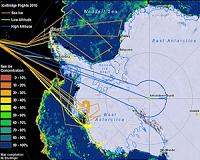| . |  |
. |
Paris, France (ESA) Apr 13, 2011 To guarantee ESA's CryoSat mission is delivering the best data possible, scientists have set out on a major expedition to the Arctic - part of a collaborative effort between ESA and NASA to gather ice measurements as the satellite orbits above. CryoSat was launched a year ago today to monitor the changes in the thickness of marine ice in the polar oceans and in the vast ice sheets that blanket Greenland and Antarctica. Orbiting closer to the poles than any other satellite and carrying the first radar altimeter of its kind, CryoSat is providing scientists with the data they need to gain a deeper understanding of the relationship between ice and climate change. As with any Earth observation mission, it is important to validate the readings acquired from space. This involves comparing the satellite data with measurements taken in situ, usually on the ground and from the air. For CryoSat, that means sending teams to one of the harshest environments on Earth. Scientists embarking on this campaign to the Arctic are not only facing the physical challenges of working in a bitterly cold and hostile environment, but also a huge logistical undertaking. Tommaso Parrinello, ESA's CryoSat Mission Manager, said, "This is one of the most important validation campaigns for CryoSat, as for the first time, we are going to measure ice simultaneously from space, from the air and on the ground." The one-month venture involves teams in central Greenland, Svalbard and the Fram Strait, Devon Island and Alert in northern Canada. While direct measurements of land and sea ice are taken on the ground, planes will be flying above taking other measurements at the same time. Notably, NASA and ESA are collaborating in this huge international effort. As part of their Icebridge airborne campaign to survey polar ice cover, NASA is taking part in joint flights with ESA planes, overflights of European ground sites and underflights of CryoSat. Malcolm Davidson, ESA's CryoSat Validation Manager said "We are excited by the collaboration with NASA. "By cooperating in collecting a huge and varied airborne dataset, probing different types of snow and ice with a range of instruments, we get a better understanding of the data from the CryoSat and ICESat missions. "This is a great opportunity to explore the possibilities of mapping ice-thickness change in the Arctic using both ESA and NASA missions." In May, ESA's team on the Greenland ice sheet will be honoured with a visit from a WWF-Netherlands delegation. As much of the Netherlands lies below sea level, WWF has a keen interest in following the developments on Greenland. The delegation will be met on the ice sheet by ESA's Director of Earth Observation Programmes, Volker Liebig, who will provide first-hand information on the CryoSat mission and the Arctic campaign. "As a science-based organisation, WWF welcomes efforts to monitor changes in the Arctic environment," said Johan van de Gronden, CEO of WWF-Netherlands. "ESA's CryoSat mission will provide precise data about ice thickness and, over time, it will measure changes in detail. Such data are needed to make informed decisions to carefully manage this fragile and rapidly changing environment."
Share This Article With Planet Earth
Related Links CryoSat Beyond the Ice Age
 Arctic Sea Ice Flights Near Completion
Arctic Sea Ice Flights Near CompletionKangerlussuaq, Greenland (SPX) Apr 13, 2011 Operation IceBridge, NASA's airborne mission to monitor polar ice, is amid its fourth week of flights for the Arctic 2011 campaign. Researchers and crew successfully completed flights from Thule, Greenland, to monitor sea ice and have now moved to Kangerlussuaq, Greenland to focus on flights monitoring the ice sheet. Flying a distance of about 19,000 miles [30,000 kilometers] over the Arct ... read more |
|
| The content herein, unless otherwise known to be public domain, are Copyright 1995-2010 - SpaceDaily. AFP and UPI Wire Stories are copyright Agence France-Presse and United Press International. ESA Portal Reports are copyright European Space Agency. All NASA sourced material is public domain. Additional copyrights may apply in whole or part to other bona fide parties. Advertising does not imply endorsement,agreement or approval of any opinions, statements or information provided by SpaceDaily on any Web page published or hosted by SpaceDaily. Privacy Statement |